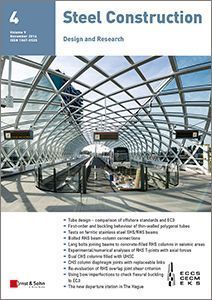Steel Construction 04/16

Curved directly glazed steel structure - the new departure station, E-Line, The Hague
by Dipl.-Ing. Thorsten Helbig, Dipl.-Ing. Florian Kamp, Roman Schieber, Dr.-Ing. Matthias Oppe, Rob Torsing and Ralph Kieft.
ZJA Zwarts & Jansma Architects have designed a new light rail departure station in The Hague, The Netherlands. The spatial roof structure of the station is made of rolled steel rectangular hollow sections arranged in two independent layers rigidly connected to each other. A glass envelope covering the roof structure matches the contours of the steel exactly. Since the diamond-shaped glass panes could only be attached to the outer layer of the steel grid, the panes (with edge lengths of approx. 1.30 m) are supported on two sides only. When optimizing the overall geometry, the double-curvature area at the nose of the roof structure became a special focus. Knippers Helbig Advanced Engineering has managed to minimize the deviation of each single glass pane from the single-curvature geometry to a maximum out-of-plane deformation of only 3 mm. Therefore, the project is a great example of how geometry development can influence structural design and enable new approaches.
The full article is published in issue 04/2016 of the journal Steel Construction.
Contents: Steel Construction 04/2016
- Tube design – comparison of offshore standards and EC3
- First-order and buckling behaviour of thin-walled polygonal tubes
- Tests on ferritic stainless steel SHS/RHS beams
- Bolted RHS beam-column connections
- Long bolts joining beams to concrete-filled RHS columns in seismic areas
- Experimental/numerical analyses of RHS T-joints with axial forces
- Dual CHS columns filled with UHSC CHS column diaphragm joints with replaceable link
- Re-evaluation of RHS overlap joint shear criterion
- Using bow imperfections to check flexural buckling to EC3
- The new departure station in The Hague
The journal Steel Construction
Steel Construction publishes peer reviewed papers covering the entire field of steel construction research. In the interests of “construction without depletion”, it skilfully combines steel with other forms of construction employing concrete, glass, cables and membranes to form integrated steelwork systems.

Since 2010 Steel Construction is the official journal for ECCS- European Convention for Constructional Steelwork members. You will find more information about membership on the ECCS homepage.
Interested? If you would like to take a closer look at the journal before subscribing, you can order a free samle copy and we will send it to you.

